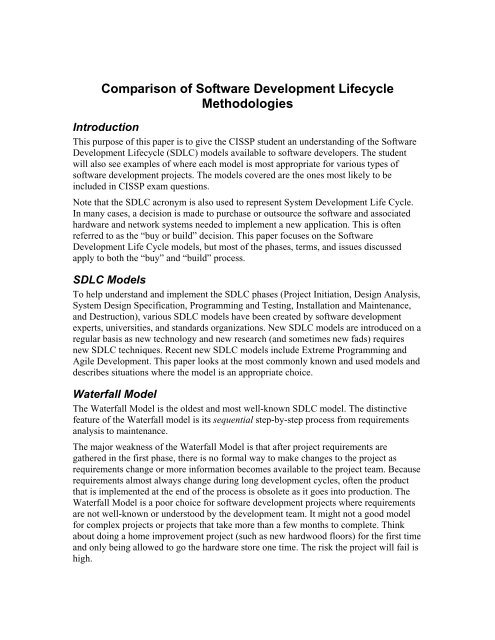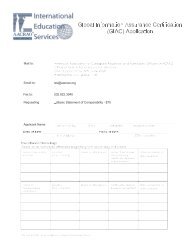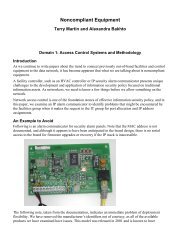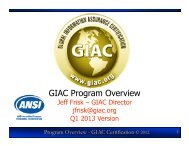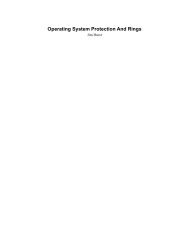Comparison of Software Development Lifecycle Methodologies - Giac
Comparison of Software Development Lifecycle Methodologies - Giac
Comparison of Software Development Lifecycle Methodologies - Giac
Create successful ePaper yourself
Turn your PDF publications into a flip-book with our unique Google optimized e-Paper software.
<strong>Comparison</strong> <strong>of</strong> S<strong>of</strong>tware <strong>Development</strong> <strong>Lifecycle</strong><br />
<strong>Methodologies</strong><br />
Introduction<br />
This purpose <strong>of</strong> this paper is to give the CISSP student an understanding <strong>of</strong> the S<strong>of</strong>tware<br />
<strong>Development</strong> <strong>Lifecycle</strong> (SDLC) models available to s<strong>of</strong>tware developers. The student<br />
will also see examples <strong>of</strong> where each model is most appropriate for various types <strong>of</strong><br />
s<strong>of</strong>tware development projects. The models covered are the ones most likely to be<br />
included in CISSP exam questions.<br />
Note that the SDLC acronym is also used to represent System <strong>Development</strong> Life Cycle.<br />
In many cases, a decision is made to purchase or outsource the s<strong>of</strong>tware and associated<br />
hardware and network systems needed to implement a new application. This is <strong>of</strong>ten<br />
referred to as the “buy or build” decision. This paper focuses on the S<strong>of</strong>tware<br />
<strong>Development</strong> Life Cycle models, but most <strong>of</strong> the phases, terms, and issues discussed<br />
apply to both the “buy” and “build” process.<br />
SDLC Models<br />
To help understand and implement the SDLC phases (Project Initiation, Design Analysis,<br />
System Design Specification, Programming and Testing, Installation and Maintenance,<br />
and Destruction), various SDLC models have been created by s<strong>of</strong>tware development<br />
experts, universities, and standards organizations. New SDLC models are introduced on a<br />
regular basis as new technology and new research (and sometimes new fads) requires<br />
new SDLC techniques. Recent new SDLC models include Extreme Programming and<br />
Agile <strong>Development</strong>. This paper looks at the most commonly known and used models and<br />
describes situations where the model is an appropriate choice.<br />
Waterfall Model<br />
The Waterfall Model is the oldest and most well-known SDLC model. The distinctive<br />
feature <strong>of</strong> the Waterfall model is its sequential step-by-step process from requirements<br />
analysis to maintenance.<br />
The major weakness <strong>of</strong> the Waterfall Model is that after project requirements are<br />
gathered in the first phase, there is no formal way to make changes to the project as<br />
requirements change or more information becomes available to the project team. Because<br />
requirements almost always change during long development cycles, <strong>of</strong>ten the product<br />
that is implemented at the end <strong>of</strong> the process is obsolete as it goes into production. The<br />
Waterfall Model is a poor choice for s<strong>of</strong>tware development projects where requirements<br />
are not well-known or understood by the development team. It might not a good model<br />
for complex projects or projects that take more than a few months to complete. Think<br />
about doing a home improvement project (such as new hardwood floors) for the first time<br />
and only being allowed to go the hardware store one time. The risk the project will fail is<br />
high.


